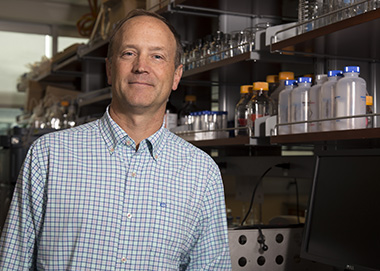Leading by Example
 |
|
Andy Berglund, director of The RNA Institute. (Photo by Patrick Dodson) |
ALBANY, N.Y. (July 25, 2019) — When he came to the University last fall as the new RNA Institute director, Andy Berglund set as a major Institute goal the training of the next generation of scientists in the RNA field, with a particular research focus on the area of myotonic dystrophy. The young researchers now working and learning at the Institute have a high standard to shoot for in this field: Berglund himself.
Berglund’s project in collaboration with neurologist Nicholas Johnson of Virginia Commonwealth, “Identifying the RNA Splicing and Gene Expression Changes that Cause Congenital Myotonic Dystrophy (TREAT CDM),” was recently funded by the National Institute of Neurological Disorders and Stroke (NINDS) of the National Institutes of Health for a total of $2,678,285 though through March of 2023.
He is also the lead investigator on two new articles: “Repeat-associated RNA structure and aberrant splicing,” in the July issue of Biochimica et Biophysica Acta, and "Gene Regulatory Mechanisms; and Combination Treatment of Erythromycin and Furamidine Provides Additive and Synergistic Rescue of Mis-splicing in Myotonic Dystrophy Type 1 Models,” published on July 23 in ACS Pharmacology & Translational Science.
Seeking New Therapies
Berglund arrived at UAlbany with another five-year grant already in hand from NINDS of the National Institutes of Health. In collaboration with Charles Thornton and colleagues at the University of Rochester, as well as from the University of Florida, their goal is to develop new therapeutic approaches for all forms of myotonic dystrophy (DM).
Myotonic dystrophy, one of the most common forms of muscular dystrophy, is a disease that can be lethal in infants and adults and is characterized by progressive disability. Approximately 40,000 Americans have DM and are afflicted with muscle weakness and prolonged muscle contractions (myotonia), which make it difficult to relax muscles after use. Eventually, many patients have difficulty walking, swallowing, and breathing.
In addition to the training of young researchers of DM and other RNA-linked diseases, Berglund said, “one of my goals is to advance our understanding of the mechanisms that cause myotonic dystrophy and develop therapeutic strategies for this common form of muscular dystrophy.”
He described the new collaborative project with Nicholas Johnson as “one in which we are working to understand the mechanisms that cause the early onset ‘congenital’ form of myotonic dystrophy.”
Preparing a New Generation
Berglund also leads an effort to train a new generation of DM researchers as director of the Educational and Training Core for the multi-investigator NINDS project with Thornton, titled the Senator Paul D. Wellstone Muscular Dystrophy Specialized Research Center. The prestigious Wellstone grant provides more than $1 million per year in funding that is split among the institutions performing the research.
Research now ongoing in the Berglund Lab at The RNA Institute is being supported by the Muscular Dystrophy Association (MDA) and Myotonic Dystrophy Foundation (MDF). The grant from the MDA is focused on repurposing compounds from other fields of research (i.e. cancer) and developing them as potential therapeutics for myotonic dystrophy. The work is being done in collaboration with medicinal chemist Rob Huigins of the University of Florida.
The research supported by MDF, which focuses on only the DM form of muscular dystrophy, has funded several trainees in the Berglund Lab. The most recent of these is PhD student Carl Shotwell, whose project is to engineer novel proteins as potential therapeutics for myotonic dystrophy.
![]() For more news, subscribe to UAlbany's RSS headline feeds
For more news, subscribe to UAlbany's RSS headline feeds
A comprehensive public research university, the University at Albany-SUNY offers more than 120 undergraduate majors and minors and 125 master's, doctoral and graduate certificate programs. UAlbany is a leader among all New York State colleges and universities in such diverse fields as atmospheric and environmental sciences, business, education, public health,health sciences, criminal justice, emergency preparedness, engineering and applied sciences, informatics, public administration, social welfare and sociology, taught by an extensive roster of faculty experts. It also offers expanded academic and research opportunities for students through an affiliation with Albany Law School. With a curriculum enhanced by 600 study-abroad opportunities, UAlbany launches great careers.


